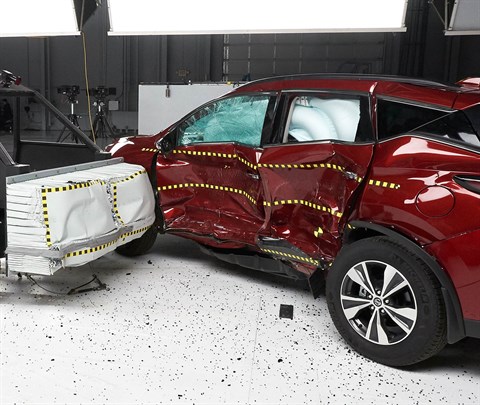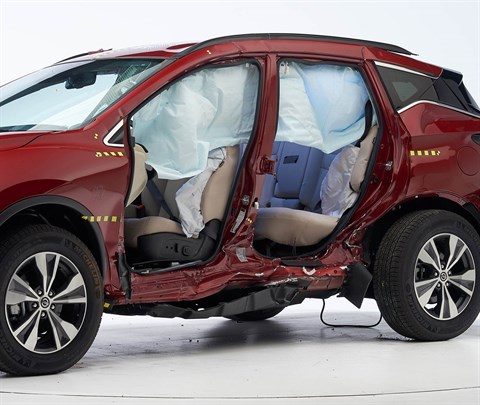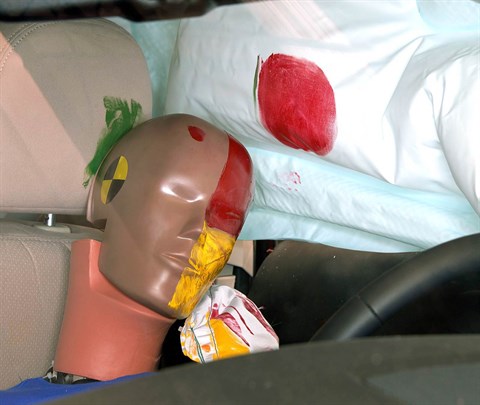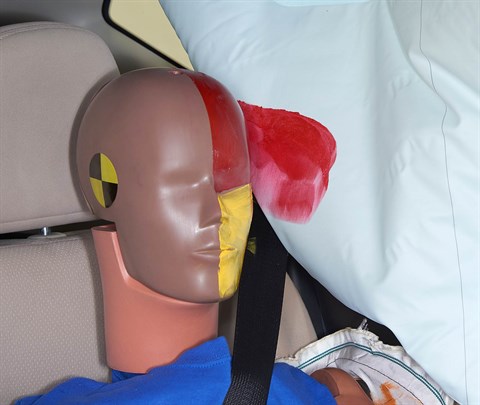Small overlap front: driver-side
Rating applies to 2019-24 models
Tested vehicle: 2019 Nissan Murano SV 4-door 4wd
The Nissan Murano was redesigned for the 2015 model year. Beginning with the 2019 model year, a knee airbag for the front passenger was added, and all of the following airbags were newly designed to improve occupant protection in both moderate overlap and small overlap frontal crashes: driver knee airbag, passenger frontal airbag, and both side curtain airbags.
Driver-side small overlap frontal ratings are assigned by the Institute based on a test conducted by Nissan. Because there were no structural changes, the structure rating of the current model is based on this test and an earlier test of a 2015 model conducted by the Institute.
| Evaluation criteria | Rating |
|---|---|
| Structure and safety cage | |
| Driver injury measures | |
| Head/neck | |
| Chest | |
| Hip/thigh | |
| Lower leg/foot | |
| Driver restraints and dummy kinematics | |
Small overlap front: passenger-side
Rating applies to 2019-24 models
Tested vehicle: 2019 Nissan Murano SV 4-door 4wd
The Nissan Murano was redesigned for the 2015 model year. Beginning with the 2019 model year, a knee airbag for the front passenger was added, and all of the following airbags were newly designed to improve occupant protection in both moderate overlap and small overlap frontal crashes: passenger frontal airbag, driver knee airbag, and both side curtain airbags.
Passenger-side small overlap frontal ratings are assigned by the Institute based on a test conducted by Nissan.
| Evaluation criteria | Rating |
|---|---|
| Overall evaluation | |
| Structure and safety cage | |
| Passenger injury measures | |
| Head/neck | |
| Chest | |
| Hip/thigh | |
| Lower leg/foot | |
| Passenger restraints and dummy kinematics The dummy’s head contacted the frontal airbag but slid off the right side, leaving the head vulnerable to contact with forward structure. The side curtain airbag deployed and has sufficient forward coverage to protect the head from contact with side structure and outside objects. | |
| Driver injury measures | |
| Head/neck | |
| Chest | |
| Hip/thigh | |
| Lower leg/foot | |
| Driver restraints and dummy kinematics | |
Moderate overlap front: original test
Rating applies to 2019-24 models
Tested vehicle: 2019 Nissan Murano SV 4-door 4wd
The Nissan Murano was redesigned for the 2015 model year. Beginning with the 2019 model year, a knee airbag for the front passenger was added, and all of the following airbags were newly designed to improve occupant protection in both moderate overlap and small overlap frontal crashes: driver knee airbag, passenger frontal airbag, and both side curtain airbags.
Moderate overlap frontal ratings are assigned by the Institute based on a test conducted by Nissan. Because there were no structural changes, the structure rating of the current model is based on this test and and an earlier test of a 2015 model also conducted by Nissan.
| Evaluation criteria | Rating |
|---|---|
| Overall evaluation | |
| Structure and safety cage | |
| Driver injury measures | |
| Head/neck | |
| Chest | |
| Leg/foot, left | |
| Leg/foot, right | |
| Driver restraints and dummy kinematics | |
Side: original test
Rating applies to 2019-24 models
Tested vehicle: 2019 Nissan Murano SL 4-door 4wd
The Nissan Murano was redesigned for the 2015 model year. Beginning with the 2019 model year, side torso airbags were added for outboard rear seat occupants, and both side curtain airbags and front-seat side torso airbags were newly designed to improve occupant protection in side impact crashes.
Side ratings are assigned by the Institute based on a test conducted by Nissan. Because there were no structural changes, the structure rating of the current model is based on this test and and an earlier test of a 2015 model also conducted by Nissan.
| Evaluation criteria | Rating |
|---|---|
| Overall evaluation | |
| Structure and safety cage | |
| Driver injury measures | |
| Head/neck | |
| Torso | |
| Pelvis/leg | |
| Driver head protection | |
| Rear passenger injury measures | |
| Head/neck | |
| Torso | |
| Pelvis/leg | |
| Rear passenger head protection | |
Side: updated test
Rating applies to 2019-24 models
Tested vehicle: 2021 Nissan Murano SV 4-door 4wd
The Nissan Murano was redesigned for the 2015 model year. Beginning with the 2019 model year, side torso airbags were added for outboard rear seat occupants, and both side curtain airbags and front-seat side torso airbags were newly designed to improve occupant protection in side impact crashes.
| Evaluation criteria | Rating |
|---|---|
| Overall evaluation | |
| Structure and safety cage | |
| Driver injury measures | |
| Head/neck | |
| Torso | |
| Pelvis | |
| Driver head protection | |
| Rear passenger injury measures | |
| Head/neck | |
| Torso | |
| Pelvis | |
| Rear passenger head protection | |

View of the vehicle just after the crash test.

View of the vehicle after the crash with doors removed, showing the side airbags and damage to the occupant compartment.

Smeared greasepaint shows where the driver dummy's head was protected from being hit by hard structures by the side airbags.

Smeared greasepaint shows where the rear passenger dummy’s head was protected by the side airbags.
Roof strength
Rating applies to 2015-23 models
Tested vehicle: 2015 Nissan Murano SV 4-door 4wd
| Overall evaluation | |
|---|---|
| Curb weight | 3,904 lbs |
| Peak force | 17,718 lbs |
| Strength-to-weight ratio | 4.54 |
Head restraints & seats
Seat type: Power cloth seat
| Overall evaluation | |
|---|---|
| Dynamic rating | |
| Seat/head restraint geometry |
About the head restraint & seat test
Currently, IIHS tests apply only to front seats.
